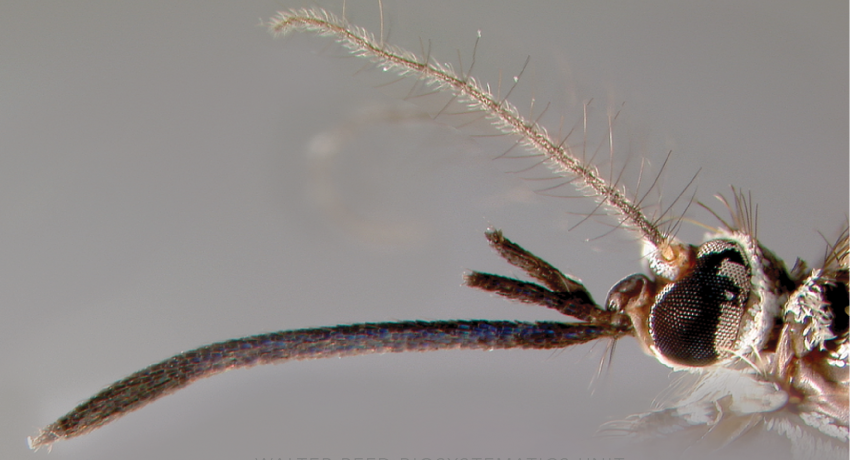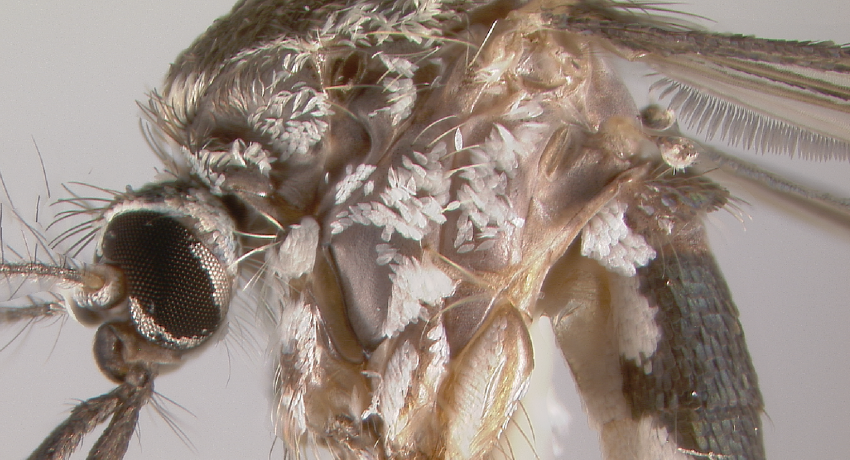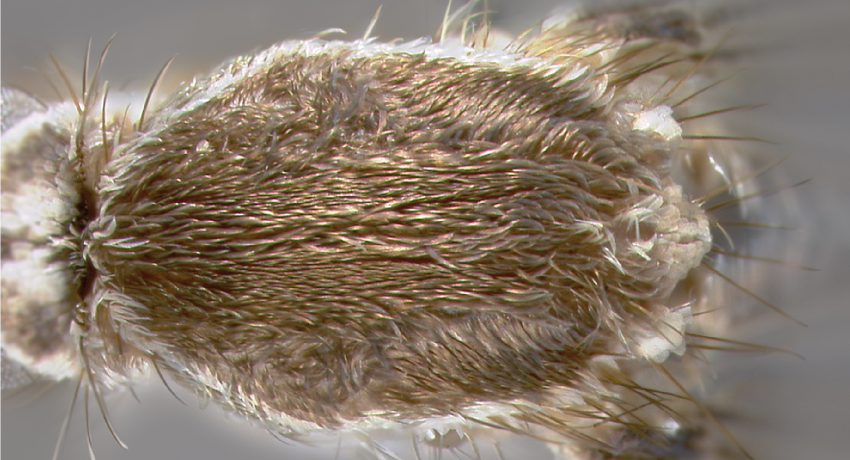ORIENTAL & PALEARCTIC REGIONS
Generic abbreviation: Ar.
Type species: Culex obturbans Walker
Etymology: armor bearer (L)
The genus Armigeres contains 58 large species subdivided into two subgenera: Armigeres (40 species) and Leicesteria (18 species). All are restricted to the Oriental Region, except Ar. (Lei.) annulipalpis (Theobald) (whose range reaches south to Ceram Island) and Ar. (Arm.) subalbatus (Coquillett), which stretches north to China, Korea and Japan. As adult females, Armigeres are easily recognized by their down-turned and laterally flattened proboscis and two long distinctive rows of scales that separate their eyes; the lack of pecten in larvae differentiates Armigeres from all other Aedines.
DIAGNOSTIC CHARACTERS (Click photos to view; mouse over and click large photo to zoom in.)
ADULT (illustrated): Head: Male palpus about as long as proboscis; female proboscis laterally compressed and slightly down-turned at tip; palpus long, slender and upturned, three-segmented with the last two segments nearly bare. Eyes separated ventrally by two long rows of scales. Thorax: Prespiracular setae absent; postspiracular area with scales, seta present or absent; base of small mesomeron more or less even with base of C-III; head scales primarily broad and flat dorsally; acrostichal and dorsocentral setae absent. Wing: Alula and upper calypter with marginal hair-like scales.
LARVA (not illustrated): Terminal segments: Pecten absent
TAXONOMIC KEYS
Barraud 1934 (India, Sri Lanka, Myanmar)
Thurman 1959b (Thailand)
Delfinado 1966a (Philippines)
Steffan 1968 (Papuan Subregion)
Tanaka et al. 1979 (Japan)
Lee et al. 1988a (Australasia)
Darsie & Pradhan 1990 (Nepal)
Darsie 2000a (Nepal)
Rattanarithikul & Harrison et al. 2005 (Thailand)
Rattanarithikul et al. 2010 (Thailand)
![]()
WRBU – Genera – Global – Larva
![]()
WRBU – Armigeres – Global – Adult
![]()
WRBU – Genera – Eastern Palearctic – Adult
![]()
WRBU – Genera – Eastern Palearctic – Larva
![]()
WRBU – Genera – Western Palearctic – Adult
![]()
WRBU – Genera – Western Palearctic – Larva
![]()
WRBU – Genera – Australasian – Adult
![]()
WRBU – Genera – Australasian – Larva
![]()
WRBU – Armigeres – Australasian – Adult
![]()
WRBU – Genera – IndoMalayan – Adult
![]()
WRBU – Genera – IndoMalayan – Larva
![]()
WRBU – Genera – Oriental – Adult
![]()
WRBU – Genera – Oriental – Larva
![]()
WRBU – Armigeres – Oriental – Adult
Exemplar DNA sequences
Ar. (Arm.) kesseli COI: MG709137
Ar. (Arm.) malayi COI: MG242529
Ar. (Arm.) subalbatus COI: KJ768155, KJ768109, KC970284–91
Ar. (Lei.) flavus COI: KU530125
BIONOMICS
Immatures
Armigeres immatures are found in natural small container habitats where waters are extremely foul or with high organic content, including tree holes, hollow logs, tree, banana and palm stumps, split and broken bamboo, pitcher plants, leaf axils, fallen leaves/spathes and fallen fruit husks. In urban areas, immature Ar. subalbatus are common in septic tanks, cesspools and cement tanks. The modified larval mouthparts of some Armigeres (Armigeres) species—including Ar. obturbans and Ar. subalbatus—suggests that some species may be predatory, or that their modified structures are used to rasp at fruit husks.
Adults
Although Armigeres species are mainly associated with jungle and jungle-edge plantations, some species now thrive in urban and semi-urban areas. Armigeres (Leicesteria) species are associated with lowland and dipterocarp forests, but never primary forests. Many species of Armigeres readily attack man. Often are reported to bite during the day, Armigeres females are most active at dawn and dusk.
Armigeres eggs are laid singly and are susceptible to desiccation. Females of some Armigeres (Leicesteria)—Ar. annulitarsis (Leicester), Ar. balteatus Macdonald, Ar. flavus (Leicester), Ar. inchoatus Barraud, Ar. magnus (Theobald) and Ar. traubi (Macdonald)—gather all their laid eggs and attach them to their hind legs, before transferring and releasing them as eggs or incompletely hatched larvae onto preferred water surfaces, or into tiny protected habitats such as bamboo insect rot holes (Ar. flavus). This curious behavior is evidenced in museum species, preserved with egg batches attached to the hind legs.
*Associated pathogens: This list reports bacteria, viruses, and parasites recovered from, or experimentally passed through this species, and does not imply field vector status.
IMPORTANT REFERENCES (full citations below)
Brunetti 1914: 55 (designation of type species)
Barraud 1934: 310, 313 (keys, morphology; India, Sri Lanka, Myanmar)
Thurman 1959b: (keys; Thailand)
Delfinado 1966a: (keys; Philippines)
Steffan 1968b: 135 (keys; Papuan Subregion)
Tanaka et al. 1979 (keys, bionomics; Japan)
Lee et al. 1988a: (key; Australasia)
Darsie & Pradhan 1990 (keys; Nepal)
Darsie 2000a (key, pupae; Nepal)
Reinert et al. 2004 (phylogeny, classification)
Rattanarithikul & Harrison et al. 2005 (F, L; keys, bionomics; Thailand)
Reinert et al. 2009 (phylogeny, classification)
Rattanarithikul et al. 2010 (F*, L*; keys, bionomics; Thailand)
Wilkerson et al. 2015 (phylogeny, classification)
Soghigian et al. 2017 (molecular phylogeny)
VALID SUBGENERA
Armigeres Theobald [Arm.]
Leicesteria Theobald [Lei.]
CURRENT GENERIC SYNONYMS
syn. Blanchardiomyia Brunetti 1912: 440 (as genus). Type species: Culex obturbans Walker.
syn. Desvoidya Blanchard 1901b: 1046 (Dec. 6). Type species: Culex obturbans Walker. Theobald 1903a: 134 (as Desvoidea, lapsus).
syn. Desvoidea Theobald 1903a: 134 (variant spelling of Desvoidya Blanchard).
syn. Neosquamomyia Taylor 1914d: 186 (as genus). Type species: Neosquamomyia breinli Taylor.
CITED REFERENCES
Barraud, P. J. (1934). The fauna of British India, including Ceylon and Burma. Diptera. Vol. 5. Family Culicidae, tribes Megarhinini and Culicini (Vol. 5). London: Taylor and Francis.
Blanchard, R. (1901). Observations sur quelques moustiques. Comptes Rendus des Seances de la Société de Biologie, 53, 1045–1046.
Brunetti, E. (1912). Annotated catalogue of Oriental Culicidae - Supplement. Records of the Indian Museum, 4, 403–517.
Brunetti, E. (1914). Critical review of genera in Culicidae. Records of the Indian Museum, 10(2), 15–73.
Darsie, R.F., Jr. (2000a). Description of the pupa of Armigeres (Leicesteria) omissus (Edwards) and a key to the larvae and pupae of the Armigeres occurring in Nepal (Diptera: Culicidae). Proceedings of the Entomological Society of Washington, 102(4), 964-94–968.
Darsie, R.F., Jr., & Pradhan, S.P. (1990). The mosquitoes of Nepal: Their identification, distribution and biology. Mosquito Systematics, 22(2), 69–130.
Delfinado, M.D. (1966a). The culicine mosquitoes of the Philippines, tribe Culicini (Diptera, Culicidae). Memoirs of the American Entomological Institute, 7, 1–252.
Lee, D.J., Hicks, M.M., Griffiths, M., Debenham, M.L., Bryan, J.H., Russell, R.C., . . . Marks, E.N. (1988a). The Culicidae of the Australasian region. Volume 6. Commonwealth Department of Health, School of Public Health and Tropical Medicine Monograph Series, 2.
Rattanarithikul, R., Harbach, R.E., Harrison, B.A., Panthusiri, P., Coleman, R.E., & Richardson, J.H. (2010). Illustrated keys to the mosquitoes of Thailand VI. Tribe Aedini. Southeast Asian Journal of Tropical Medicine and Public Health, 41(1), 1–225.
Rattanarithikul, R., Harrison, B.A., Panthusiri, P., & Coleman, R.E. (2005). Illustrated keys to the mosquitoes of Thailand. I. Background; geographic distribution; lists of genera, subgenera, and species; and a key to the genera. Southeast Asian Journal of Tropical Medicine and Public Health, 36(1), 1–80.
Reinert, J.F., Harbach, R.E., & Kitching, I.J. (2004). Phylogeny and classification of Aedini (Diptera: Culicidae), based on morphological characters of all life stages. Zoological Journal of the Linnean Society, 142, 289–368.
Reinert, J.F., Harbach, R.E., & Kitching, I.J. (2009). Phylogeny and classification of tribe Aedini (Diptera: Culicidae). Zoological Journal of the Linnean Society, 157(4), 700–794.
Soghigian, J., Andreadis, T.G., & Livdahl, T.P. (2017). From ground pools to treeholes: convergent evolution of habitat and phenotype in Aedes mosquitoes. BMC Evolutionary Biology, 17, 262.
Steffan, W.A. (1968b). Armigeres of the Papuan subregion (Diptera: Culicidae). Journal of Medical Entomology, 5(2), 135–159.
Tanaka, K., Mizusawa, K., & Saugstad, E.S. (1979). A revision of the adult and larval mosquitoes of Japan (including the Ryukyu Archipelago and Ogasawara Islands) and Korea (Diptera: Culicidae). Contributions of the American Entomological Institute, 16, 1–987.
Taylor, F.H. (1914d). Culicidae from Papua. Transactions of the Royal Entomological Society of London, 185–205.
Theobald, F.V. (1901a). A monograph of the Culicidae or mosquitoes (Vol. 1). London: British Museum (Natural History). [424pp]
Theobald, F.V. (1901b). The classification of mosquitoes. Journal of Tropical Medicine, 4, 229–235.
Theobald, F.V. (1903a). A monograph of the Culicidae of the World (Vol. 3). London: British Museum (Natural History). 359pp
Thurman, E.B. (1959b). A contribution to a revision of the Culicidae of northern Thailand. Bulletin of the University of Maryland Agriculture Experimental Station A, 100, 1–177.
Wilkerson, R.C., Linton, Y.-M., Fonseca, D., Schultz, T., Price, D., & Strickman, D. (2015). Making mosquito taxonomy useful: A stable classification of tribe Aedini that balances utility with current knowledge of evolutionary relationships. PLoS ONE, 10(7), e0133602.
CITE THIS PAGE
Walter Reed Biosystematics Unit (Year). Armigeres genus page. Walter Reed Biosystematics Unit Website, http://wrbu.si.edu/vectorspecies/genera/armigeres, accessed on [date (e.g. 03 February 2020) when you last viewed the site].





